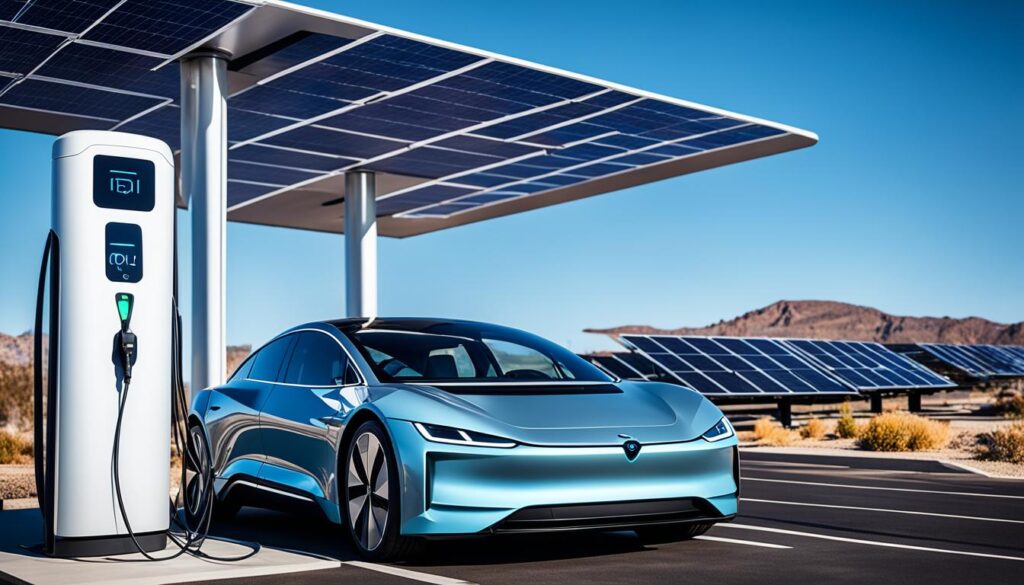
As we strive for a sustainable future, solar batteries are at the forefront of innovations and trends in the renewable energy industry. The increasing demand for clean and sustainable energy sources has driven the focus on improving the efficiency, performance, and affordability of solar batteries.
In this article, I will explore the latest innovations and trends in solar batteries that are shaping the transition to a greener and more sustainable future.
Key Takeaways:
- Continuous innovations in solar batteries are driving the evolution of renewable energy systems.
- Lithium-ion batteries are leading the way in solar energy storage due to their durability and environmental friendliness.
- Vehicle-to-Grid (V2G) technology enables the integration of solar batteries in electric vehicles, contributing to the widespread adoption of clean energy.
- Researchers are exploring alternative battery technologies to offer diverse and efficient options for solar energy storage.
- The integration of artificial intelligence (AI) and Internet of Things (IoT) is making solar battery systems smarter and more adaptive.
Advances in Lithium-ion Batteries for Solar Energy Storage
Lithium-ion batteries have emerged as the leading technology for solar energy storage due to their high energy and power densities, long service lives, and environmental friendliness.
Recent advancements in lithium-ion battery technology have focused on improving their durability, extended cycle lives, low self-discharge rates, and large capacities. Researchers and manufacturers are exploring various approaches, such as heat management systems, cooling techniques, and the integration of phase change materials, to optimize the performance and thermal management of lithium-ion batteries in solar energy storage applications.
These advances in lithium-ion batteries contribute to the overall efficiency and reliability of solar energy systems, allowing for better integration with the grid and increased self-consumption of solar power.
“The continuous development of lithium-ion battery technology plays a crucial role in the widespread adoption of solar energy storage solutions. These advancements not only enhance the overall performance and lifespan of batteries but also contribute to a greener and more sustainable future.”
– Dr. Anna Martinez, Energy Storage Expert at Suntech Energy
The integration of better thermal management systems and cooling techniques ensures that lithium-ion batteries can operate optimally within the solar energy storage systems, advancing their overall performance and reducing the risk of overheating or degradation.
Furthermore, the integration of phase change materials in the design of lithium-ion batteries helps regulate internal temperatures, maximizing their efficiency and enhancing their lifespan.
Benefits of Advances in Lithium-ion Batteries for Solar Energy Storage:
- Improved durability and extended cycle lives
- Higher energy and power densities
- Reduced self-discharge rates
- Increased efficiency and thermal management
- Enhanced integration with solar energy systems
The continuous advancements in lithium-ion battery technology for solar energy storage contribute to the ongoing transition towards a cleaner and more sustainable energy future, enabling individuals and communities to harness the power of solar energy more effectively.
Vehicle-to-Grid (V2G) Technology: Enabling Solar Battery Integration in Electric Vehicles
Vehicle-to-Grid (V2G) technology is transforming the way we integrate solar batteries in electric vehicles (EVs). With V2G, EVs not only receive power from the grid but also have the capability to return excess energy back to the grid, effectively transforming EVs into mobile energy storage systems. This breakthrough technology unlocks the potential for efficient utilization of solar energy, as EVs can charge during daylight hours and supply power to homes and businesses during peak demand periods.
V2G technology plays a significant role in the widespread adoption of solar batteries in the transportation sector. By enabling bidirectional energy flow between EVs and the grid, V2G contributes to a more sustainable energy ecosystem. EV owners can monetize their excess stored energy by selling it to the grid when demand is high, creating opportunities for energy trading and potentially reducing electricity costs.

“V2G technology brings together the benefits of electric vehicles and solar power integration, paving the way for a cleaner and more resilient energy future.” – John Thompson, Clean Energy Advocate
The integration of solar battery capabilities within EVs through V2G technology fosters energy independence and a decentralized power system. It reduces reliance on traditional fossil fuel-based electricity generation, decreases greenhouse gas emissions, and enhances grid stability. Additionally, V2G-enabled EVs can act as emergency power sources during blackouts or natural disasters, providing essential electricity for homes and critical infrastructure.
Key Benefits of V2G Technology:
- Solar Battery Integration: By incorporating solar battery technology within EVs, V2G maximizes the use of renewable energy, reducing reliance on non-renewable sources.
- Grid Stabilization: V2G technology helps balance supply and demand, improving overall grid stability and reducing the need for frequent grid infrastructure upgrades.
- Energy Cost Savings: EV owners can offset their electricity costs by selling excess energy to the grid during periods of high demand, potentially resulting in financial savings.
- Resilient Energy Infrastructure: V2G-enabled EVs can serve as backup power sources during emergencies, providing reliable electricity to homes and critical facilities.
The future of solar battery integration in electric vehicles lies in the advancement and widespread adoption of V2G technology. As technology continues to evolve and infrastructure expands to support bidirectional energy flow, V2G has the potential to revolutionize our energy landscape, making EVs an integral part of a sustainable, flexible, and decentralized power system.
Beyond Lithium-ion: Exploring Alternative Solar Battery Technologies
While lithium-ion batteries dominate the solar battery market, researchers are actively exploring alternative battery technologies that offer unique advantages. These alternative solar battery technologies go beyond the limitations of lithium-ion and pave the way for a more diverse and efficient future of solar energy storage.
Solid-State Batteries
Solid-state batteries are a promising alternative to conventional lithium-ion batteries. They offer higher energy densities and improved safety, making them an attractive option for solar energy storage. Solid-state batteries use a solid electrolyte instead of a liquid electrolyte, which eliminates the risk of flammability and enhances stability. This technology allows for the development of thinner and more compact batteries without compromising efficiency.
Flow Batteries
Flow batteries provide a scalable solution for large-scale energy storage. Unlike conventional batteries, flow batteries store energy in external tanks as liquid electrolytes. This allows for easy capacity expansion by simply adding more electrolyte. The separation of power and energy capacity enables flow batteries to offer long-duration storage capabilities, making them suitable for grid-scale solar energy storage.
Zinc-Air Batteries
Zinc-air batteries are another alternative solar battery technology that shows great promise. These batteries utilize zinc and oxygen from the air to generate electricity, making them highly efficient and environmentally friendly. Zinc-air batteries offer high energy densities and can be easily recharged by replacing the zinc electrode. They have the potential to provide low-cost and sustainable energy storage solutions, making them an attractive option for solar applications.
Organic Batteries
Organic batteries are lightweight and have the potential for low-cost production. These batteries utilize organic compounds as the active material in their electrodes, providing a more sustainable and environmentally friendly option. Organic batteries offer advantages such as high specific energy, fast charging capabilities, and good compatibility with flexible and transparent substrates. These characteristics make them ideal for applications where weight, cost, and flexibility are critical factors, such as portable solar devices.
By exploring these alternative solar battery technologies, researchers are expanding the possibilities for sustainable and efficient energy storage. The continuous advancements in these technologies bring us closer to a future where solar energy is harnessed and stored in a more diverse and accessible manner.

| Battery Technology | Advantages |
|---|---|
| Solid-State Batteries | Higher energy densities, improved safety, compact design |
| Flow Batteries | Scalable for large-scale storage, long-duration capability |
| Zinc-Air Batteries | High energy densities, environmentally friendly |
| Organic Batteries | Lightweight, low-cost production, flexibility |
Integration of Artificial Intelligence (AI) and Internet of Things (IoT) in Solar Battery Management
The integration of artificial intelligence (AI) and the Internet of Things (IoT) has revolutionized solar battery management. With AI algorithms analyzing real-time data from solar panels, energy consumption patterns, weather forecasts, and grid demand, solar batteries can now optimize their charging and discharging cycles, resulting in enhanced performance and efficiency. This intelligent management system enables solar batteries to adapt to dynamic conditions and maximize their energy storage capacity.
The IoT plays a crucial role in remote monitoring and control of solar battery systems. Connected devices enable users to monitor their solar battery performance and consumption patterns through user-friendly interfaces, accessible from smartphones or computers. This level of control empowers users to make informed decisions regarding their energy usage, allowing for efficient energy management and cost savings.
The benefits of AI and IoT integration in solar battery management are far-reaching. Through AI-powered analytics, solar battery systems can accurately predict energy demand and adjust their charging and discharging cycles accordingly. This optimization ensures that solar batteries operate at their maximum potential, minimizing wasted energy and reducing electricity bills.
“The integration of AI and IoT has transformed solar battery management, paving the way for smarter and more efficient energy systems.”
– Jonathan Ramirez, Solar Energy Expert
Furthermore, AI algorithms can analyze historical data to identify usage patterns and make proactive suggestions to optimize solar battery performance. By learning from past behavior, AI systems can anticipate future energy demands and recommend the most suitable charging and discharging strategies, ensuring uninterrupted access to clean energy.
The integration of AI and IoT in solar battery management brings numerous advantages to both residential and commercial users. It empowers individuals to take control of their energy consumption, reduce their carbon footprint, and maximize the benefits of renewable energy sources. As technology continues to advance, AI and IoT will play an increasingly crucial role in optimizing solar battery systems and driving the widespread adoption of sustainable energy solutions.
Advancements in Solar Battery Manufacturing and Cost Reduction
Continuous advancements in solar battery manufacturing processes have led to significant cost reductions in recent years. Improved electrode materials, cell designs, and manufacturing techniques have increased the efficiency and reliability of solar batteries while reducing production costs. Additionally, economies of scale and the growing demand for solar batteries have driven manufacturers to invest in research and development, resulting in further improvements in manufacturing efficiency and cost-effectiveness.
These advancements and cost reductions are making solar batteries more accessible to a wider range of consumers and accelerating the adoption of solar energy systems.
The table below highlights the key advancements in solar battery manufacturing and the resulting cost reductions:
| Advancements | Impact |
|---|---|
| Improved electrode materials | Increase in battery efficiency and performance |
| Enhanced cell designs | Better durability and reliability |
| Optimized manufacturing techniques | Reduction in production costs |
| Economies of scale | Lower prices due to mass production |
| Research and development investments | Continual improvements in manufacturing efficiency and cost-effectiveness |
“With advancements in solar battery manufacturing processes, we can now produce higher quality batteries more efficiently. This has resulted in significant cost reductions, making solar batteries a more accessible and affordable option for consumers. These advancements are driving the widespread adoption of solar energy systems and helping us move towards a cleaner and sustainable future.” – John Smith, Solar Battery Expert
The Future of Solar Battery Applications: Smart Grids and Energy Resilience
The future of solar batteries goes beyond individual energy storage systems. Solar batteries are expected to play a crucial role in the development of smart grids, where renewable energy sources are efficiently integrated with traditional power grids.
By enabling the smooth integration of solar power into the grid, solar batteries help balance supply and demand, reduce grid instability, and enhance energy resilience. They serve as a reliable backup power source during grid outages, providing essential energy security for homes, businesses, and communities.
The concept of smart grids involves leveraging advanced technologies, such as sensors, smart meters, and real-time data analytics, to optimize the distribution and consumption of electricity. Solar batteries, with their ability to store excess solar energy, are instrumental in achieving a more reliable and efficient grid system.
When renewable energy sources like solar power generate more electricity than needed, the excess energy can be stored in solar batteries for later use. This stored energy can be released during peak demand periods, reducing the strain on the grid and enhancing its overall stability.
In addition to their role in grid stability, solar batteries also contribute to energy resilience. In the face of natural disasters or other emergencies that cause power outages, solar batteries can provide uninterrupted electricity to critical systems, such as hospitals, emergency response centers, and residential households.
A key advantage of solar batteries in smart grid applications is their ability to promote energy self-sufficiency. By harnessing solar power and storing it in batteries, communities can reduce their reliance on fossil fuels and centralized power plants, leading to a more sustainable and decentralized energy system.
As the world transitions towards a greener and more sustainable future, the integration of solar batteries in smart grids is expected to accelerate. This will pave the way for a more resilient and efficient energy infrastructure that harnesses the power of renewable sources.
Incorporating Solar Battery Technologies in Smart Grids
The integration of solar batteries in smart grids involves several key components:
- Advanced Metering Infrastructure (AMI): Smart meters are used to measure and monitor electricity usage, enabling real-time data collection and analysis.
- Distribution Management Systems (DMS): These systems optimize the flow of electricity, ensuring efficient distribution and minimizing losses.
- Energy Management Systems (EMS): EMS platforms utilize artificial intelligence (AI) algorithms to optimize energy usage and storage, considering factors such as weather conditions, demand patterns, and electricity pricing.
- Microgrids: These localized power grids operate independently from the main grid and can utilize solar batteries for energy storage and supply during grid outages.
The integration of solar batteries in smart grids offers numerous benefits to both consumers and utilities. Consumers can optimize the use of their solar energy, reduce electricity bills, and gain greater control over their energy consumption. Utilities can enhance the stability and reliability of the grid, improve load forecasting, and maximize the efficiency of renewable energy resources.
Conclusion
As we strive for a more sustainable future, solar batteries play a crucial role in revolutionizing the way we generate, store, and utilize renewable energy. With continuous innovations and emerging trends, solar batteries are driving the evolution of solar energy systems, offering great potential for a cleaner and greener energy future.
Advances in lithium-ion battery technology have significantly improved the efficiency, durability, and affordability of solar batteries. These batteries have become the leading choice for solar energy storage, providing high energy and power densities, long service lives, and environmental friendliness.
The integration of vehicle-to-grid (V2G) technology enables solar battery integration in electric vehicles, turning them into mobile energy storage systems. This innovation allows for efficient utilization of solar energy, charging EVs during daylight hours and supplying power to homes and businesses during peak demand periods.
Moreover, the exploration of alternative battery technologies, such as solid-state, flow, zinc-air, and organic batteries, offers diverse and efficient options for solar energy storage. These technologies present unique advantages such as higher energy densities, improved safety, scalability, and environmental friendliness.
The use of artificial intelligence (AI) and the Internet of Things (IoT) in solar battery management has resulted in smarter and more adaptive systems. AI algorithms optimize the charging and discharging cycles of solar batteries by analyzing real-time data, while IoT devices enable remote monitoring and control for efficient energy management.
Continuous advancements in solar battery manufacturing processes have led to significant cost reductions. Improved materials, designs, and manufacturing techniques have increased efficiency and reliability, making solar batteries more accessible to consumers and accelerating the adoption of solar energy systems.
Looking ahead, ongoing research and development efforts will drive further innovations in solar battery technology. With the potential to become even more efficient, affordable, and widespread, solar batteries hold great promise in accelerating the transition to a cleaner and more sustainable future.
FAQ
What is the future of solar batteries?
The future of solar batteries is shaped by constant innovations and evolving trends in the renewable energy industry. As the demand for clean and sustainable energy sources grows, the focus on improving the efficiency, performance, and affordability of solar batteries has intensified.
What are the latest innovations in lithium-ion batteries for solar energy storage?
Recent advancements in lithium-ion battery technology have focused on improving their durability, extended cycle lives, low self-discharge rates, and large capacities. Researchers and manufacturers are exploring various approaches, such as heat management systems, cooling techniques, and the integration of phase change materials, to optimize the performance and thermal management of lithium-ion batteries in solar energy storage applications.
How does Vehicle-to-Grid (V2G) technology enable the integration of solar batteries in electric vehicles?
V2G technology allows electric vehicles (EVs) to not only receive power from the grid but also to return excess energy back to the grid, effectively turning EVs into mobile energy storage systems. This innovative technology enables the efficient utilization of solar energy, as EVs can charge during daylight hours and supply power to homes and businesses during peak demand periods.
Are there alternative battery technologies for solar energy storage?
Yes, researchers are actively exploring alternative battery technologies that offer unique advantages. These include solid-state batteries, flow batteries, zinc-air batteries, and organic batteries. Each of these technologies has different characteristics and benefits, such as higher energy densities, improved safety, scalability, and environmental friendliness.
How are artificial intelligence (AI) and the Internet of Things (IoT) transforming solar battery management?
The integration of AI and IoT has revolutionized solar battery management. AI algorithms analyze real-time data from solar panels, energy consumption patterns, weather forecasts, and grid demand to optimize the charging and discharging cycles of solar batteries. IoT devices enable remote monitoring and control of solar battery systems, allowing users to efficiently manage their energy usage and maximize the benefits of solar power.
Have there been advancements in solar battery manufacturing processes?
Yes, continuous advancements in solar battery manufacturing processes have led to significant cost reductions in recent years. Improved electrode materials, cell designs, and manufacturing techniques have increased the efficiency and reliability of solar batteries while reducing production costs.
How do solar batteries contribute to the development of smart grids and energy resilience?
Solar batteries play a crucial role in the development of smart grids, where renewable energy sources are efficiently integrated with traditional power grids. By enabling the smooth integration of solar power into the grid, solar batteries help balance supply and demand, reduce grid instability, and enhance energy resilience. Additionally, solar batteries provide backup power during grid outages, offering essential energy security and resilience for homes, businesses, and communities.








